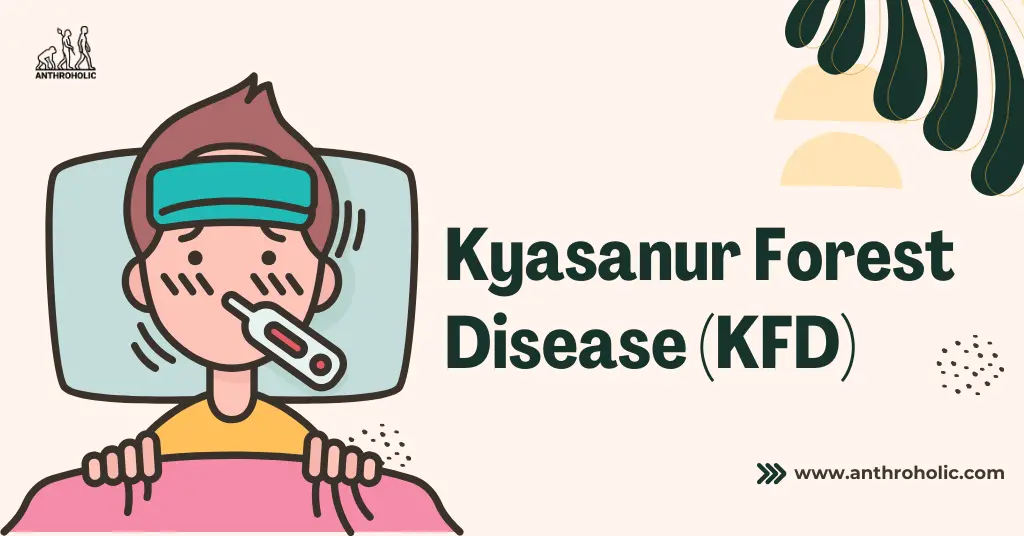AI Answer Evaluation Platform Live Now. Try Free Answer Evaluation Now
Kyasanur Forest Disease
Kyasanur Forest Disease (KFD), also known as Monkey Fever, is a tick-borne viral hemorrhagic fever endemic to South Asia. Originating from the Kyasanur Forest in Karnataka, India, KFD has serious implications on the socio-economic, cultural, and health dimensions of affected communities [1].

Epidemiology and Transmission
The Virus and Its Transmission
KFD is caused by the Kyasanur Forest Disease Virus (KFDV), a member of the Flaviviridae family. The primary vectors are ticks, particularly Haemaphysalis spinigera [2].
| Transmission Source | Comments |
|---|---|
| Ticks | Main vector for KFD |
| Monkeys | Serve as reservoir hosts |
| Small mammals | Potential reservoirs |
Affected Regions
The disease initially emerged in Karnataka but has now spread to neighboring states such as Kerala and Goa [3]. The spread relates to the movement and behavior of local communities and the prevalence of vectors in different environmental niches.
Cultural and Social Impact
Relationship with Forest
Many tribal and local communities are heavily dependent on forests. The exposure to ticks while gathering forest products or during agricultural activities has led to increased incidences of KFD among these populations [4].
Social Stigma and Myths
Stigma around KFD can lead to ostracization and the emergence of myths and misconceptions that impact both prevention and treatment.
Economic Impact
KFD has a direct effect on the livelihoods of those dependent on agriculture and forest resources. The table below captures the economic dimensions.
| Economic Aspect | Impact of KFD |
|---|---|
| Agricultural Productivity | Decrease due to labor loss |
| Healthcare Costs | Increase in family expenditure |
| Tourism | Decline in affected regions |
Healthcare Challenges
Lack of Awareness
The lack of awareness and education regarding KFD is a significant challenge, leading to delayed diagnosis and treatment.
Healthcare Infrastructure
Limited healthcare facilities and shortage of vaccines are major obstacles in KFD management in rural areas.
Community Response and Traditional Knowledge
Community Beliefs and Practices
Understanding the indigenous and traditional knowledge systems in affected regions is crucial to devise strategies that resonate with local communities. Some communities have developed traditional practices and beliefs regarding the avoidance of certain areas during specific times to minimize exposure to KFD.
Community Engagement
Effective control and prevention of KFD requires active participation and awareness within local communities. In some areas, Community Health Workers (CHWs) have been pivotal in creating awareness and administering vaccines.
Prevention and Control Measures
Vaccination
The KFD vaccine, although available, suffers from limited coverage, and acceptance varies across regions and communities.
Environmental Control
Efforts to manage the vector population through controlled burns and acaricide applications in the forests have been experimented with, but with varying success.
Governmental Policies and Strategies
Surveillance and Reporting
The Indian government has established surveillance and reporting systems in endemic regions. Early detection and rapid response are crucial to control outbreaks.
Inter-sectoral Collaboration
Collaboration between health, forestry, agriculture, and tribal welfare departments is essential to tackle KFD effectively. Some states have initiated such inter-departmental coordination.
Healthcare Challenges
Lack of Awareness
The lack of awareness and education regarding KFD is a significant challenge, leading to delayed diagnosis and treatment.
Healthcare Infrastructure
Limited healthcare facilities and shortage of vaccines are major obstacles in KFD management in rural areas.
Conclusion
Kyasanur Forest Disease is not merely a medical issue but encapsulates broader social, economic, and cultural concerns. A comprehensive understanding requires a multidisciplinary approach, considering anthropological insights. Future research must focus on community engagement, inter-sectoral collaboration, and the development of robust healthcare infrastructure.
References
[1] Pattnaik, P. (2006). Kyasanur forest disease: an epidemiological view in India. Rev. Sci. Tech., 25(3), 981-987.
[2] Dodd, K.A., et al. (2011). Kyasanur Forest disease virus infection in mice is associated with higher morbidity and mortality than infection with the closely related Alkhurma hemorrhagic fever virus. Am. J. Trop. Med. Hyg., 84(6), 908-913.
[3] Murhekar, M., et al. (2015). On the transmission pattern of Kyasanur Forest disease (KFD) in India. Infect. Dis. Poverty, 4, 37.
[4] Gurav, Y.K., et al. (2013). A Comparative Study of the Kyasanur Forest Disease among Different Tribes of Shimoga District, Karnataka, India. J. Global Infect. Dis., 5(3), 102-106.




